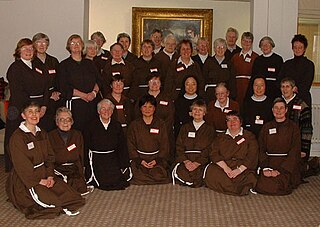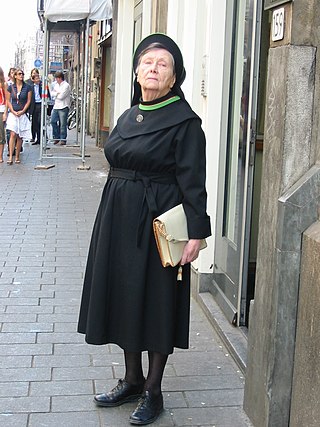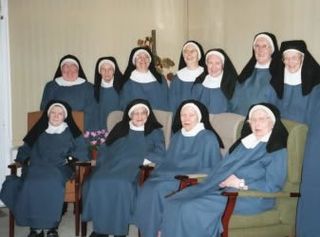
A nun is a woman who vows to dedicate her life to religious service and contemplation, typically living under vows of poverty, chastity, and obedience in the enclosure of a monastery or convent. The term is often used interchangeably with religious sisters who do take simple vows but live an active vocation of prayer and charitable work.

A convent is a community of monks, nuns, friars or religious sisters. Alternatively, convent means the building used by the community. The word is particularly used in the Catholic Church, Lutheran churches, and the Anglican Communion.
A religious order is a lineage of communities and organizations of people who live in some way set apart from society in accordance with their specific religious devotion, usually characterized by the principles of its founder's religious practice. It is usually composed of laypeople and, in some orders, clergy. Such orders exist in many of the world's religions.

Burnham is a large village and civil parish that lies north of the River Thames in Buckinghamshire, between the towns of Maidenhead and Slough, about 24 miles west of Charing Cross, London. It is probably best known for the nearby Burnham Beeches woodland.
A canoness is a member of a religious community of vowed women, historically a stable community dedicated to the celebration of the Liturgy of the Hours in a particular church. The name corresponds to a canon, the male equivalent, and both roles share a common historical origin. As with the canons, there are two types: canonesses regular, who follow the Rule of St Augustine, and secular canonesses, who follow no monastic rule of life.

Anglican religious orders are communities of men or women in the Anglican Communion who live under a common rule of life. The members of religious orders take vows which often include the traditional monastic vows of poverty, chastity and obedience, or the ancient vow of stability, or sometimes a modern interpretation of some or all of these vows. Members may be laity or clergy, but most commonly include a mixture of both. They lead a common life of work and prayer, sometimes on a single site, sometimes spread over multiple locations. Though many Anglicans are members of religious orders recognized by the Anglican Communion, others may be members of ecumenical Protestant or Old Catholic religious orders while maintaining their Anglican identity and parochial membership in Anglican churches.

There are a number of Benedictine Anglican religious orders, some of them using the name Order of St. Benedict (OSB). Just like their Roman Catholic counterparts, each abbey/priory/convent is independent of each other. The vows are not made to an order, but to a local incarnation of the order, hence each individual order is free to develop its own character and charism, yet each under a common rule of life after the precepts of St. Benedict. Most of the communities include a confraternity of oblates. The order consists of a number of independent communities.
The Sisters of Charity (SC) is an Anglican religious order following the Rule of St. Vincent de Paul, and so committed to the service of those in need. The Order was founded in 1869. From their mission house in Plymouth, England, the sisters are involved in parish and mission work. The community also maintains a nursing home near Plymouth. The order maintains a confraternity of oblates.
The Chama cha Mariamu Mtakatifu, (CMM) is a large Anglican religious order operating within the Anglican Church of Tanzania, and with its headquarters at Masasi, Tanzania.

The Community of St. Francis (CSF) is a Franciscan Anglican religious order of sisters founded in 1905, and is the oldest surviving Anglican Franciscan religious community. As First Order sisters, the CSF is an autonomous part of the Society of St. Francis, which also includes the Order of St. Clare, and a Third Order of secular members living as a dispersed community. Living under a Franciscan Rule, the sisters' primary vocation is prayer, study, and work in the context of community life. Some sisters serve as priests, and others live a solitary life.

The Community of St John Baptist (CSJB), also known as the Sisters of Mercy, or formerly Clewer Sisters, is an Anglican religious order of Augustinian nuns.

The Community of the Resurrection (CR) is an Anglican religious community for men in England. It is based in Mirfield, West Yorkshire, and has 14 members as of April 2023. The community reflects Anglicanism in its broad nature and is strongly engaged in the life of the Anglican Communion. It also has a long tradition of ecumenical outlook and practice.

Augustinian nuns are the most ancient and continuous segment of the Roman Catholic Augustinian religious order under the canons of contemporary historical method. The Augustinian nuns, named after Saint Augustine of Hippo, are several Roman Catholic enclosed monastic communities of women living according to a guide to religious life known as the Rule of St. Augustine. Prominent Augustinian nuns include Italian mystic St. Clare of Montefalco and St. Rita of Cascia.

Burnham Abbey was a house of Augustinian canonesses regular near Burnham in Buckinghamshire, England. It was founded in 1266 by Richard, 1st Earl of Cornwall. The abbey of St Mary consisted of around twenty nuns at the outset, but was never wealthy and by the time of its dissolution in 1539 there were only ten.
The Community of the Holy Name (CHN) is an international Anglican religious order for women. The full name of the community is The Community of the Mission Sisters of the Holy Name of Jesus, usually shortened to Community of the Holy Name. The order currently operates in Europe and Africa. There is also an order operating in Australia with the same name which has an independent history, having been founded entirely separately.
Augustinian nuns are named after Saint Augustine of Hippo and exist in the Roman Catholic and Anglican churches. In the Roman Catholic Church there are both enclosed monastic orders of women living according to a guide to religious life known as the Rule of St Augustine, and also other independent Augustinian congregations living in the spirit of this rule. In the Anglican Communion, there is no single "Order of St Augustine", but a number of Augustinian congregations of sisters living according to the Rule of St Augustine.
Former religious orders in the churches of the Anglican Communion are those communities of monks, nuns, friars, or sisters, having a common life and rule under vows, whose work has ended and whose community has been disbanded. In a very few cases this is due to the termination of the work for which the community was established, but in most cases it is due to amalgamation or the death of the final remaining member of the community.

The Society of the Sisters of Bethany (SSB) is an Anglican religious order. The sisters follow the Rule of St Augustine. The mother house is now the House of Bethany in Southsea.
St Jude's Church, Birmingham was a parish church in the Church of England in Birmingham.












